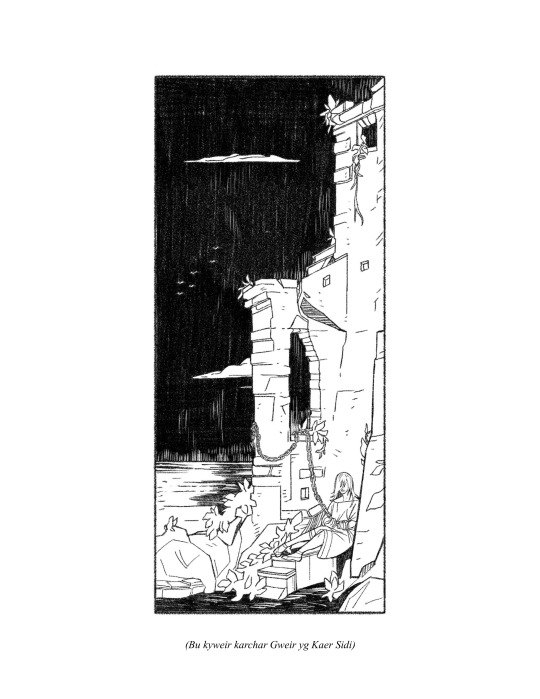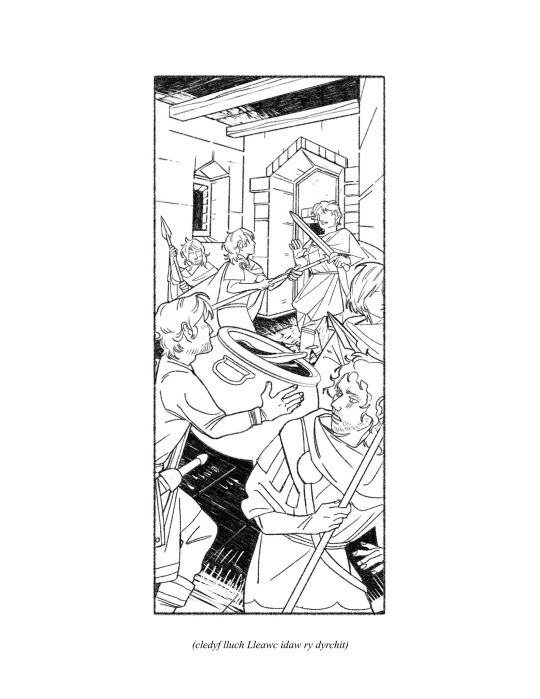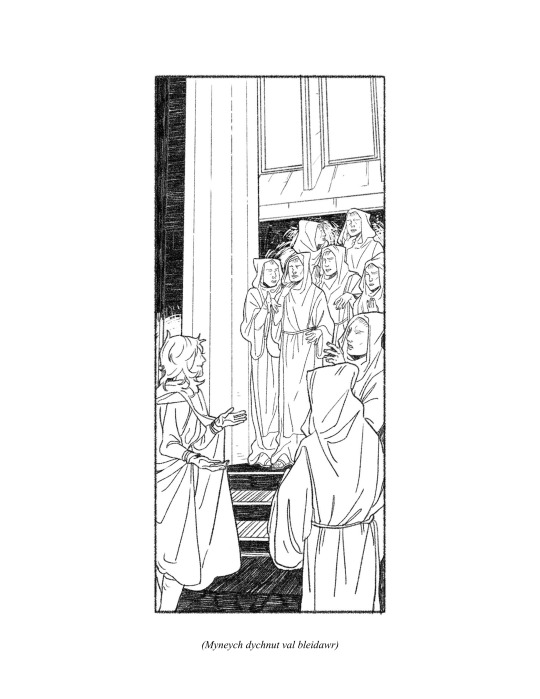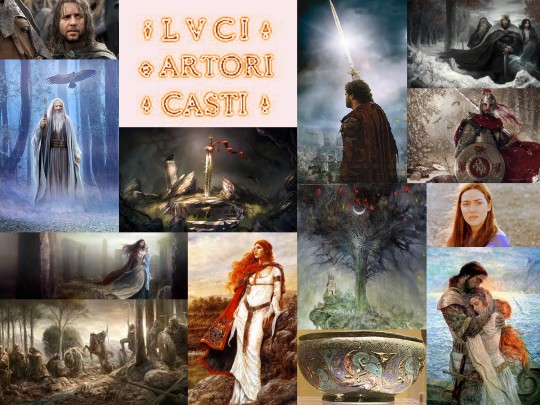#the fort is in the otherworld/annwn
Explore tagged Tumblr posts
Text



Some illustrations I made for a module as interpretations of some passages from the Welsh poem 'Preiddeu Annwn'
#yippie!!! yahoo!!!!#i wrote 8k words on this im gonna PASS OUT NOW#how do i tag this??#posting this feels like such an intense ‘and now for something completely different’#taliesin#preiddeu annwn#annwfn#welsh#celtic#first illustration caption: maintained was Gwair’s prison in Caer Siddi#second: Lleog’s flashing sword was thrust into it#(though I made it a spear for a better composition)#third: monks congregate like wolves#quick explanation of Gwair:#likely either Gweir ap Gweirioed or Gweir ap Gwystyl#or a combo of both#Gweirioed is known for being a prisoner likely of the Isle of Wight or Lundy island#potentially connected to the first branch of the Mabinogion#Gwystyl is named in peredur as one of three knights from Arthur’s court and is frequently referenced for his dismal dispositation and sadnes#caer siddi is likely meant to be a reference to the fae#mead feast fort and several other names are given to it later#other translations have been Mound Fort (like fairy mound)#the fort is in the otherworld/annwn#Arthur and a retinue of men went to the otherworld to#supposedly retrieve a cauldron#specifically a cauldron that is one of the thirteen treasures of the island of Britain#likely the cauldron of dyrnwch the giant#welsh literature#medieval literature
62 notes
·
View notes
Text
Trying To Analyze All The References/Connections To Arthurian Mythos in HNOC (that I can catch)
So I’m a fucking nerd who knows a lot about King Arthur and his knights so HNOC made me go absolutely feral because of these references, so I’m gonna try to dissect them all. (under the cut cause this got LONG)
I’m going to try and go in order here, so let’s start with The Tower and Gunfight at Dolorous Guard.
1. Dolorous Guard is a fort that Lancelot comes across before becoming one of Arthur’s knights. While there, he frees it from a curse and an evil king and renames it Joyus Guard. He also learns of his identity as a lost French prince, and that is where he is later buried. After his affair with Guinevere is discovered by Arthur, they run off to Joyus Guard and the name changes back.
2. Arthur’s gun is a “Clarent 10 caliber railgun” and the 10 Caliber is supposed to sound like “Excalibur”, Arthur’s legendary sword.
3. Arthur pulls the star off of Sheriff Stone, a reference to the Sword In The Stone story that marks Arthur as the true king, or in this case, sheriff (also Excalibur is a different sword most of the time)
Strength and Empty Trail
1. Annwn, where the corpses go and where the ghouls live, is the “Otherworld” in Welsh mythology. There is an old poem in which Arthur goes to Annwn, and Morgan Le Fay, a prominent character in Arthurian legend, is also thought to have been drawn from Welsh mythology. Sometimes Morgan is Arthur’s older sister, sometimes she’s Mordred’s mother, sometimes both (gross).
2. Gawain is one of the more well known of Arthur’s knights, even though he doesn’t do... a lot. He’s a relatively normal dude, but notably, he’s usually Mordred’s brother, and always a close friend of Lancelot. When Lancelot comes back for Guinevere after the scandal is uncovered, he is nearly captured, and kills Gawain’s brothers and sons to escape. Gawain is so angry about this that he drags Arthur into war with Lancelot, which allows Mordred to usurp the throne. He forgive Lancelot on his death bed and begs him to come back and defeat Mordred. Basically, the characterization of “being a bit too angry gets everyone killed” tracks.
Death and The Hanged Man Rusts
1. Mordred. Oh boy Mordred. Morgause is sometimes Mordred’s mother, and also Arthur’s half sister (gross), so that’s why that’s Mordred’s dead name. It’s always a thing that Arthur doesn’t know Mordred is his son for whatever reason, and Mordred always overthrows Arthur (though with more malicious intent than he does in HNOC).
2. Galahad! Galahad is Lancelot’s son with Elaine of Corbenic, who tricks him into thinking she’s Guinevere so he’ll sleep with her. Galahad kinda replaced Lancelot as the Grail Knight, because people didn’t really like an adulterer being the chosen one. Galahad is basically Lancelot but better so that they can have a more pure guy as the Grail Knight.
The Hieorphant and Hellfire
1. The seat that Galahad sits in that drives him mad is a thing from his version of the Grail Quest. The seat is meant for the Grail Knight, and if you sat in it and weren’t the Grail Knight, it would kill you, as shown. Galahad is new to the Round Table when he sits in it, and when it doesn’t kill him, he becomes the designated Grail Knight. Yay!
2. Avalon, the name of the star, is also the name of Morgan Le Fay’s home, and where she takes Arthur to try and save his life after his final battle with Mordred.
3. Fort Galfridian is a reference to the two “eras” of Arthurian myth, pre-galfridian and post-galfridian. Post-galfridian defines weather or not a piece of King Arthur literature is influenced by the writer Geoffrey of Monmouth’s work.
The Lovers and Blood and Whiskey
1. There’s not really much here which is nice, but as I mentioned, Guinevere is married to Arthur from the beginning, but when Lancelot gets introduced, he also starts an affair with Guinevere that is either very good or very bad depending on the writer. The Mechanisms said fuck that shit what if they just talked it out and were poly. Good for them. They also mention Joyus Guard here.
The Fool and Skin and Bone
1. King Arthur is a very British hero. When Britain was in its VERY early days, they had two main enemies, the Anglo-Saxons and the Gaels. So that’s why the ghouls/Saxons are called that. Saxon being a name derived from their seax knives is also just where the word comes from so that’s cool.
2. Mordred being the son of Arthur but raised in an outside place also goes with his mother sometimes being Morgan Le Fay, as she was a faerie or witch in most myths, and as such an outcast from British society in general.
The Hermit and Holder of the Grail
1. The other two knights that are killed in The Hermit are Bors and Percival. Percival was the Grail Knight before Lancelot was introduced. Bors and Percival also both go on the Grail Quest with Lancelot and Galahad, and Galahad, Percival, and Bors, all get to see the Grail while Lancelot usually doesn’t. I guess dying from the turrets is how you see the Grail.
2. Joseph Robert Mathea, the captain, can also be refereed to as Joseph R Mathea. Joseph of Arimathea (pronounced the same) is the man who supposedly brought the grail to Britain. Nice. (someone else pointed this out first but I can’t for the life of me remember who someone help).
Judgement and Peacemaker
1. Camelot is refereed to as being in the “Camlann wastes”. Camlann is Arthur’s final battle against Mordred, where he is fatally wounded.
2. Mordred refers to Gawain as “brother” which, as I said, is usually a part of their backstories.
Justice and Once and Future King
1. Mordred always fatally wounds Arthur in the Battle of Camlann. Mordred dies, as does Arthur. While Arthur doesn’t die in HNOC, Mordred CERTAINLY DOES.
2. Arthur and Merlin/Drumbot Brian are the only two people who survive High Noon Over Camelot. Arthur and Merlin also both fall into the King Under the Mountain trope. This is a trope where a big important hero is buried/entombed somewhere and promises to come back in their land’s greatest hour of need. So in this case, Living is what ends out classifying them as Kings Under the Mountain.
3. Once and Future King is also the title of a book series that is based on Le Morte D’Arthur! I have never read those books though so idk if that’s where the similarities end or not
#high noon over camelot#hnoc#the mechanisms#also this is definitley reaching but joseph of armithea also shows up in like. the bible#and all of stone's clan have very biblical names (like ruth and jezebel and ezikial)#and i don't think there's an intentional similarity there but I still find that interesting
260 notes
·
View notes
Photo

“Well-prepared was the prison of Gweir in the Mound Fortress [Caer Sidi]... “No one before him went into it, into the heavy grey-blue chain; a faithful servant it held. And before the Spoils of Annwn, he bitterly sang...” “My poetry, from the cauldron it was uttered. From the breath of nine maidens was it [the cauldron fire] kindled “The cauldron of the chief of Annwn, what is its fashion? A dark ridge around its border and pearls. It does not boil the food of a coward... “And before the door of hell, lamps burned...” ~Preiddu Annwn: “...thought to have been composed from the 6th-9th centuries AD, we read of a cryptic expedition to the Otherworld engaged by Arthur and his retinue of three ships, although for what reason is not made clear. Annwn here is a prison for Gweir, one of the 'three exalted prisoners of the Island of Britain' in the Welsh Triads – it is possible they sought to rescue him or to retrieve the magic cauldron that he sings of:..”
~Geoffrey describes Morgen thusly: “The one who is first among them has greater skill in healing, as her beauty surpasses that of her sisters. Her name is Morgen, and she has learned the uses of all plants in curing the ills of the body. She knows, too, the art of changing her shape, of flying through the air, like Daedalus, on strange wings. At will, she is now at Brest, now at Chartres, now at Pavia; and at will she glides down from the sky on to your shores. They say she had taught astrology to her sisters…”
However, having said this, it is true that Geoffrey’s Avalon goddesses remind us to an uncanny degree of the Gallizenas of the island of Sena, modern Ile de Sein, off Pointe du Raz on the western coast of Brittany, mentioned by Pomponius Mela in c. 40 CE: “Sena in the British sea, opposite the Ossismician coast, is remarkable for an oracle of the Gallic God. Its priestesses, holy in perpetual virginity, are said to be nine in number. They are called Gallizenas, and are thought to be endowed with singular powers, so as to raise by their charms the winds and seas, to turn themselves into what animals they will, to cure wounds and diseases incurable by others, to know and predict the future; but this they do only to navigators who go thither purposely to consult them.”
“We have seen above that the Arthurian ‘Lady of the Lake’ was, in reality, Dea Latis of the Avalon Roman fort at Burgh-By-Sands, Cumbria. But later Arthurian romance would further identify her as Niviane or Viviane. Where did the French romance authors get this name for the lake goddess? In Welsh tradition, Nyfain (variants Nyuein, Nyven, Nevyn) daughter of Brychan is the name given to the mother of Urien. This Brychan is said to be the famous Irish chieftain known to have founded the Welsh kingdom of Brycheiniog and to have fathered eleven sons and twenty-four daughters. However, there was also a Northern Brychan, whom the Welsh sources associate with a Manaw, supposedly either Manau Gododdin at the head of the Firth of Forth, or the Manau that was the Isle of Man. The tomb of this Northern Brychan is either on an island called the Island of Brychan, which is near or bordering on Manaw, or is at a place called the Valley of Brychan within Manaw itself. No satisfactory site has been identified fitting these descriptions. However, as Gaelic corrie means ‘valley’, the Valley of Brychan is certainly an error for the Coire or ‘Cauldron’ of Breccan, i.e. the Corrievreckan, the name of a whirlpool situated between the Inner Hebridean islands of Jura and Scarba. Today this location is marked on maps by the Gulf of Corryvreckan. In the Metrical Dindshenchas (Part 18), we are told the following about Breccan’s fate in the whirlpool: “No generous chieftain that reached it ever returned hither again from its white-paven floor, since Breccán of Bérre went his way. Breccán son of Partholan, that seer of old, drank no wholesome draught: he was drowned here with his fifty ships by the crowding waves of the whirlpool. I know the tale sages tell of the mighty whirlpool's home, whence comes, to denote it perpetually, the familiar name and its clear reason. I have heard of famous Breccán, whose is the loud-roaring grave—him that enriched every hearth of Uí Néill, busily plying in his vessel a brisk trade. Breccán son of Maine, rich in graces, the Cauldron drowned with its red spray, and he lies under the heavy high-piled strand with his ship and his valiant following. Though it has buried unforgotten Breccán, his name endures in story with his bark and its burthen that lie beneath the whirlpool's stormy water.”
http://www.visionaryartexhibition.com/archaic-visions/musings-on-archaic-images-of-avalon
http://mistshadows.blogspot.com/2016/07/the-arthur-of-history-chapter-five.html
1 note
·
View note